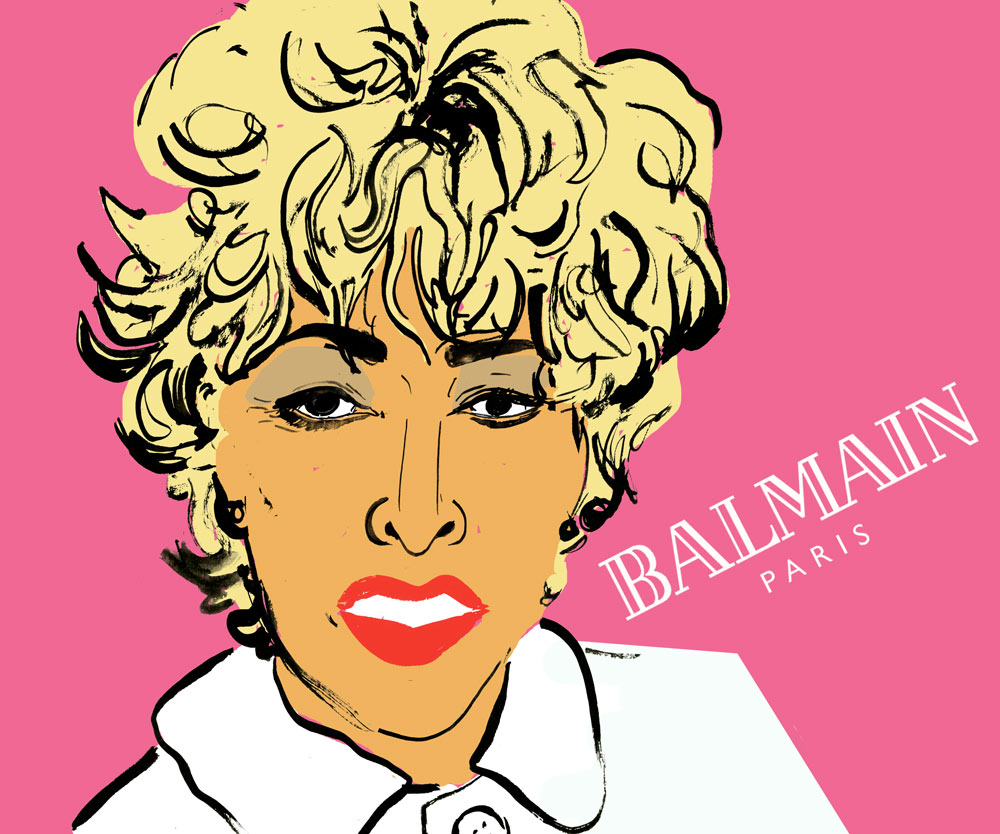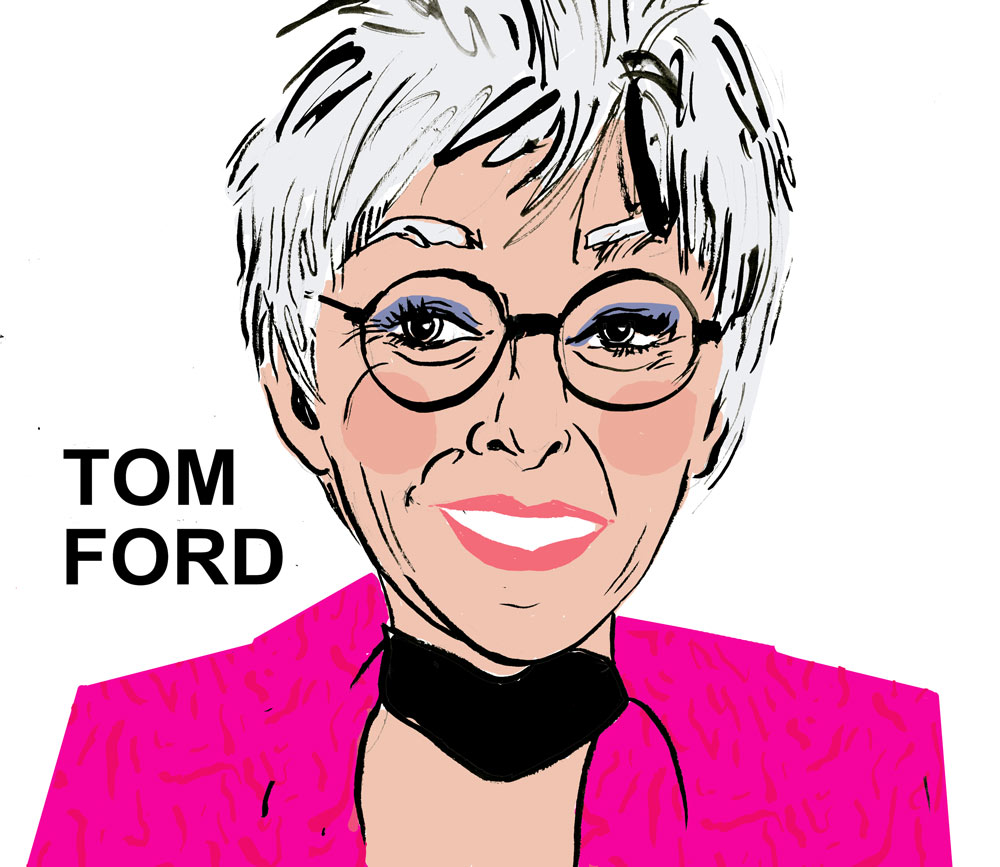Lack of racial diversity is glaringly clear within the trend of older women (like Iris Apfel) modeling for major fashion campaigns.
by Kristina Bustos
illustrations by Kate Worum
For decades, the default formula for a successful fashion campaign was “fresh-faced, twenty-something ‘it’ girl.” But fashion brands are starting to tweak that formula. Now, the older the model, the more buzzworthy the campaign.
This spring alone, we’ve seen legendary author Joan Didion, 80, look cool in all black for Céline and 71-year-old folk rock icon Joni Mitchell strum her guitar in a black and white ad for Saint Laurent Paris. 93-year-old fashion icon and famed interior decorator Iris Apfel is also getting a lot of renewed attention. On April 29, Magnolia Pictures released a documentary dedicated to her unique style titled Iris. The queen of colorful mixing and matching recently starred in back-to-back campaigns—one for jewelry label Alexis Bittar in January and the other for fashion and lifestyle company Kate Spade. Then there was Oscar winner Hellen Mirren, 69, looking confident for beauty giant L’Oréal and social media’s coolest grandma Baddie Winkle donning a white swimsuit for Dimepiece. Before all these women, there was former actress Jacky O’Shaughnessy, who became a model at 60 for American Apparel in 2012—a clothing brand known for its controversial ads that often feature young, barely-dressed models.
The trend of famous older woman over 60 taking over fashion and beauty campaigns not only helps to diversify a notoriously homogenous industry, it also brings forth a new image of women who can be glamourous, fierce and sensual with gray hair and wrinkles.
But this current industry trend is not without its problems. All the women mentioned above are white, and a Google search for “older women of color in fashion ads” doesn’t actually yield any women of color. You’ll have a little more luck searching for “older women of color in beauty ads.” Among the array of images, you’ll notice an older nude black woman, who is part of Dove’s 2007 “Beauty has no age limit” campaign. Yet, of the six women featured in that campaign, only two are black. Clearly, women of color are once again being sidelined in the fashion and beauty industry.
“Women of color have powerful pockets and it spans across more than the beauty industry,” says Christina Brown, LoveBrownSugar style blogger and digital media expert. “We’re buying designer clothes as well. So why shouldn’t I have the ability to see someone who looks like me on the runway? Wherever I’m spending money is where I deserve representation. And that’s everywhere!”
This isn’t to say that women, like the ones mentioned above, are only selling to or inspiring their similar-looking peers. In fact, when Céline unveiled Didion as its muse this past January, there was plenty of chatter among young people, ranging from praise to criticism about the campaign. Even I, a twenty-something Asian-American, thought it was cool to see Didion and Joni Mitchell in fashion campaigns, and I’ll definitely be watching the documentary about Aphel. But the selection of these famous older white women is a continued reflection of the lack of racial representation throughout the fashion landscape.
At this year’s Fall 2015 fashion week in New York, London, Milan and Paris, The Fashion Spot reported that “out of 9,538 model bookings in 373 shows, 80% were white — a ratio that closely resembles Spring 2015 (83%).” The Fashion Spot also did research on the lack of diversity among magazine covers published in 2014. They found that 119 out of 611 total magazine covers from 44 major print magazines only featured models of color—whether they were celebrities or not. You also have to take into account the disparity of the different ethnic groups in those statistics: 60 were black, 53 were Asian, 4 were Latino and 2 were “other.” The numbers are disheartening because it seems that no matter how many studies and think pieces are done to illustrate the lack of racial representation in the fashion landscape, there’s still so much to be done.
“I think it’s an ongoing battle to get more representation of women of color in the fashion industry,” says Brown, who thinks the fashion industry is “lagging behind tremendously” on diversity. “Regardless of what the ‘trends’ are, there are always more opportunities for the powers that be to include women of color in their campaigns.”
But Brown does cite fashion designer Diane von Furstenberg, 68, as an industry leader making efforts to change the fashion industry. Von Furstenberg, a prominent and respected figure in the industry, is the president of the Council of Fashion Designers of America (CFDA). In February, days before New York Fashion Week, she and CFDA’s CEO Steven Kolb addressed the industry in a letter reminding designers to support model-turned-fashion activist Bethann Hardison’s Balance Diversity initiative. Hardison, along with fellow black models Iman and Beverly Johnson, helped break racial barriers in the modeling industry in the 1970s. In 2013, Hardison organized the Diversity Coalition, and became an activist for models of color everywhere. The Balance Diversity initiative was “created to consistently improve racial diversity in the fashion industry permanently.” A couple of the guidelines included: “Encourage the industry to be inclusive of racial diversity when preparing casting of models for their company needs” and “Be open minded to models of color. Make an effort to add diversity to your lineup. It affects how we see things globally and how we are seen as an industry.” But even as industry leaders actively push for diversity, the lack of racial representation on the runways, fashion magazines and campaigns is still glaring.
“There should be more advocates for diversity at every level,” Brown adds. “The more people focus on diversity and inclusion, the faster the industry will change.”
Adweek reported that “people over 60 make up the fastest growing group of consumers in the world,” constituting 800 million of the global population in 2010. Surely, within that population, older white females aren’t the only major consumers who keep the “Silver Economy” flourishing. But the surge of fashion and beauty ads featuring older women would show otherwise. If there’s one thing that the blog Advanced Style proves, it’s that older women of all races love and enjoy fashion. The blog’s creator Ari Seth Cohen, who co-wrote and starred in a documentary inspired by his blog, photographs stylish older women on the streets of New York. In a recent photo, Cohen spotlights an older black woman named Elva who clearly knows a thing or two about statement pieces. Last month, Cohen featured photos of an older Asian woman who showed off her beautiful kimono. Back in February, media company Fusion came out with its own “dream casting” of “super women” gracing fashion ads instead of supermodels, choosing women of different ages, races, physical appearances and gender identities—from Supreme Court Justice Ruth Bader Ginsburg and “Orange is the New Black” star Laverne Cox to Nobel Peace Prize-winner Malala Yousafzai.
This inspired me to add more names to this “dream casting.” Tina Turner, who at 75 still has it, would rock a sexy campaign for haute couture label Balmain. Puerto Rican actress and singer Rita Moreno, 83, proves that you can look fabulous wearing eyeglasses at her age, making her perfect for Tom Ford’s eyewear collections. And Iranian American actress Shohreh Aghdashloo, 62, embodies the elegance of the late Oscar de la Renta’s design aesthetic. Now, tell us that you don’t want to see these come to life.
[hr style=”striped”]
Kristina Bustos is a contributing writer for The Riveter and Digital Spy. She was an editor at fashion blog The Blay Report as well as a contributor for Honey, Essence, and Audrey magazines.You can follow her on Twitter and Instagram at @krisbustos.
Kate Worum is a Minneapolis based creative. Her work is a mix of playful illustration and bold design. She has a BFA from the Minneapolis College of Art and Design. To see more of her work visit www.kateworum.com





